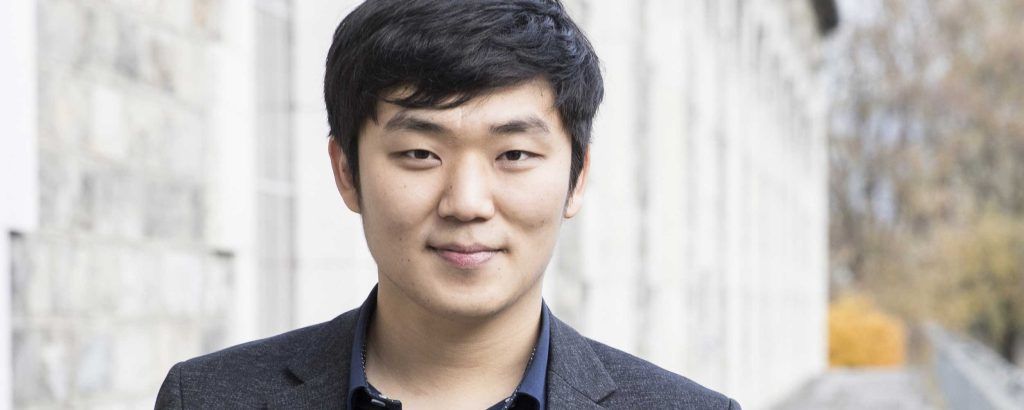Hankyeol Yoon at his italian debut: February 9 and 10, 2024

On Friday and Saturday, February 9th and 10th 2024, at 8pm in Mehta Hall, maestro Hankyeol Yoon, making his debut in Italy, conducts the Maggio Orchestra and Choir.
The music of Johannes Brahms and Antonín Dvořák is on the program.
The concert will be broadcast deferred on Rai Radio 3
Florence, February 6th 2024 – After the last two concerts held by maestro Daniele Gatti, last January, the Maggio Winter Season continues with another double symphonic appointment in the Zubin Mehta Hall: on the podium, Friday and Saturday, February 9th and 10th 2024, at 8pm, maestro Hankyeol Yoon marks his Italian debut at the helm of the Orchestra and Choir of the Maggio Musicale Fiorentino.
The young Korean maestro takes to the podium after the concert performance of Grieg's Peer Gynt, which saw Nikolas Naegele conduct the Maggio Orchestra and Choir on January 16th and 17th. Yoon and Naegele are two young and talented conductors that Maggio has decided to place alongside the main conductor Daniele Gatti and his two concerts (next one schedule for March 16th), to present them to the Florentine public together with the subsequent Min Chung and Vitali Alekseenok, in course of the winter symphony programming.
They are four artists, all very interesting and aged between their thirty and forty; they already have a brilliant career and are highly appreciated at a European level with great successes achieved in the major opera houses and concert halls. Nikolas Naegele was “born” and trained in Maggio at the Maggio’s Academy and was then Kapellmeister at the Deutsche Oper in Berlin and assistant to Christian Thieleman several times in Salzburg and Bayreuth; Min Chung, has an important international curriculum, Vitali Alekseenok winner of the Toscanini competition in 2021 and, in '23, second in the Karajan competition, now holds the role of Kapellmeister of the Deutsche Oper am Rhein.
Hankyeol Yoon, already a multiple award winner in numerous competitions, recently won the prestigious first prize "Herbert von Karajan Young Conductors Award" in 2023. Thanks to this important victory, Maggio Fiorentino offered him his Italian debut, anticipating the one at the Salzburg Festival next August.
Speaking about the concerts on Friday and Saturday, Maestro Yoon underlined the richness of the program, and how, despite the musical differences, Brahms was a convinced supporter (and mentor) of Antonín Dvořák: “We know that throughout his life Brahms was a supporter of Dvořák and almost his mentor, Dvořák having always been an admirer of Brahms' work. We can also notice some similarities between the two as regards the composition technique, although the differences in the musical field are evident: while Brahms, in full German tradition, is certainly more serious and capable of 'moving' fibers of the heart almost hidden, Dvořák instead has a decidedly more extroverted conception of music and sound.”
Opening the evening, therefore, is the Academic Festival Overture (Akademische Festouvertüre) op. 80 by Johannes Brahms, followed by two other compositions by the great German composer: Nänie op. 82 and Das Schicksalslied (Song of Destiny) op. 54. The concert closes with Symphony no. 8 in G major op. 88 by Antonín Dvořák. The master of the Maggio Chorus is Lorenzo Fratini.
The concert program
Johannes Brahms - Academic Festival Overture (Akademische Festouvertüre) op. 80
The two orchestral overtures of the Brahmsian catalog - the Academic and the Tragic - both saw the light in the summer of 1880 during the summer holiday period in Ischl. In March of the previous year Brahms had been nominated honorary doctor of philosophy by the University of Breslau and as thanks for the honor received he decided to create the two occasion pages that were as characteristic as they were diametrically opposed. The first of the two, Akademische Festouvertüre (Academic Festival Overture) op. 80, has a cheerful and brilliant character also underlined by the title, which was not intended to allude to pedantic respect for tradition but rather to the light-heartedness typical of the years of youthful study. In fact, the overture does not follow any classical formal scheme and each episode of the four in which it is divided is characterized by themes taken from well-known student songs from the German area. Even though it was an occasion piece, Brahms did not save on resources by showing off a full orchestra which also included a triangle, cymbals and bass drum, called upon to underline the noisy effect that accompanies the parade of playful songs present in the score.
Johannes Brahms - Nänie op. 82
Another piece linked to a specific event is Nänie for choir and orchestra op. 82 that Brahms composed between 1880 and 1881 in memory of the painter and friend Anselm Feuerbach who died prematurely. For this work the composer chose a poem by Schiller which describes the inevitability of death; it makes no distinction whatsoever between men, although some of them are loved and favored by the gods. A reflection on the common destiny of all living beings that Brahms musically translates into a page in tripartite form, where two sections in the Andante frame a more lively middle section. The first part is opened by the sweet intervention of the oboe which anticipates with its pastoral accents the climate of serene acceptance that distinguishes Nänie. In the central section the choral writing momentarily ignites with the re-enactment of the deaths of Adonis and Achilles and then resumes the calm pace of the beginning. For Brahms, the funeral song of the gods that rises for the death of those who embodied beauty and perfection is sweet and pacifying.
Johannes Brahms – Das Schicksalslied (The song of destiny)
After the success of the German Requiem in 1868, Brahms came across a collection of poems by Friedrich Hölderlin and was particularly struck by one of them entitled Destiny. Three years later, in 1871, he decided to cover the chosen text with notes but his work did not leave him fully satisfied. Brahms fears that he has pushed the music beyond the meaning expressed by the text and believes his Schicksalslied for choir and orchestra, Op. 54 a sort of failed experiment. The two contrasting sections of the lyric, in which the first describes the celestial world and the imperturbability of the gods who inhabit it, while the second the terrestrial world and the existential anguish of men, are musically reproduced with a skilful play of chiaroscuro (muted strings and verses intoned softly in the first part, written with strong dramatic colors in the second). After the two contrasting episodes, the work ends with an instrumental postlude which re-proposes the seraphic initial theme, a necessary expedient for the needs of musical symmetry and to give unity to the architecture of the piece.
Antonín Dvořák - Symphony no. 8 in G major op. 88
Symphony no. 8 in G major op. 88. by Dvořák was composed in the autumn of 1889 within a few weeks and performed in Prague on 2 February of the following year under the direction of the same author. In a letter sent to a friend, the musician had confided that he wanted to write a symphony "different from the others, with the individual ideas elaborated in a new way", almost a sort of departure from the venerated model of Brahm-sian symphony, followed up to that point, in favor of a rhapsodic and narrative language, typical of the Slavic musical tradition, which proceeds through poetic images rather than complex thematic elaborations. And that in this symphony the freedom of invention was primary compared to the rigor of traditional construction Dvořák demonstrates from the first bars of the opening Allegro, a movement constructed in the key of G major which however unusually opens with a long elegiac melody intoned by cellos and horns in G minor. In the Adagio, in the form of a romance, the composer prefers the collected and meditative tone of a whispered story, while in the Allegretto grazioso he lays out an enchanting melody that moves gracefully to the rhythm of a waltz, followed in the Trio by a new thematic idea of equal sonic charm. In the Finale, a fanfare of trumpets draws attention to a speech in which a theme with a dancing rhythm is subjected to a series of increasingly rich and complex variations that lead to a festive and flamboyant coda.



